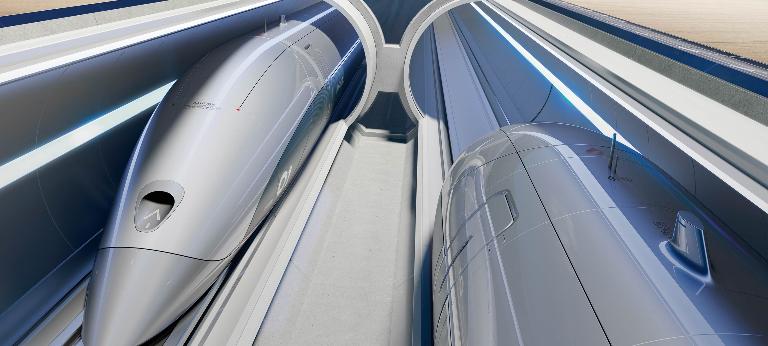Breaking the rules
![{[downloads[language].preview]}](https://www.rolandberger.com/publications/publication_image/Think_Act_Magazine_Breaking_the_rules_Cover_download_preview.jpg)
Is breaking the rules a crucial skill? We examine how the people who have made their own rules also significantly shaped the world of business.



For centuries the idea of a revolutionary super-speed vacuum train has been proposed, rejected and proposed again. But since Elon Musk gave the idea impetus by publishing a white paper five years ago, two companies have emerged pledging to turn this science fiction into fact. Their strategies are radically different. Which one – if either – will triumph?
Flight history buffs will certainly know that Charles Lindbergh was the first person to fly nonstop across the Atlantic Ocean. In 1927, he took off from a Long Island airfield in a single-seat, fixed-wing aircraft and landed some 33 hours later at an aerodrome near Paris. So far, so famous. But perhaps less recognized is the role of Raymond Orteig, the French-American hotelier who offered $25,000 to any pilot who could complete the journey. The prize, worth more than $360,000 at today's prices, kicked off a scramble of innovation and development. Fast-forward 86 years to 2013: Another entrepreneur, richer and more outspoken even than Orteig, triggered a new Great Race in transportation. Tesla and SpaceX boss Elon Musk published a white paper describing what he called a "Hyperloop," a vacuum train concept capable of propelling people and cargo through sealed tubes at 1,000 kph.
On a basic level, the idea is nothing new. It dates back to 1799, when British inventor George Medhurst patented his "atmospheric railway," proposing to conduct commuters along pressurized pipes under London. After Medhurst's original invention, more pneumatic railways were built in Ireland, the UK, France and New York – all before the end of the 19th century. As well as experimental passenger trains, smaller tube systems were created to transport mail, messages, parts for factories and medical documentation in hospitals. There have been numerous attempts to build Hyperloop-style systems since 1900, from researchers at MIT in the 1990s to a transportation startup called ET3, which designed a system for smaller car-sized pods in the early 2000s.
"Hyperloop is a cross between a Concorde, a railgun and an air hockey table."
Daydreams bounced around for 200 years, yet all lacked the necessary impetus to make the fantasy real. Musk's white paper pulled the trigger; it was an uncorking event driven by his notoriety and reputation for bringing major change to global industries. Equally important was timing: It coincided with advancements in communications, data, mapping, modeling, aerospace and the internet of things. New systems of business and organization had emerged too, including the circular economy, sharing and the concept of "the crowd." Unlike the groups vying for the Orteig Prize, startups rising to meet Musk's challenge had a chance to deploy these innovations and make the Hyperloop happen. Since 2013, a wide variety of organizations have worked on the concept, but two, Virgin Hyperloop One (VHO) and Hyperloop Transportation Technologies (HTT), have emerged as major players. Unlike existing rail companies, tech giants or aerospace firms, these had no legacy systems or generations of previous models, just a blank sheet of paper and endless options for plotting a course into the future.
It's perhaps not surprising that they picked contrasting strategies. While Virgin Hyperloop One assembled a team, built a test track in the Californian desert and convinced Sir Richard Branson to invest and join as chairman, Hyperloop Transportation Technologies did none of these things. Instead, founders Bibop Gresta and Dirk Ahlborn created a crowdsourcing model and invited participation from scientists, engineers and a whole network of experts from around the world. "I met Dirk at an event in Santa Monica," explains Gresta, HTT's chairman. "He had created a website called the JumpStartFund, which hosts projects and invites people to participate in return for stock options. He published Elon Musk's white paper on the website and 100 people from 20 countries asked to join the team. He convinced me to read a document his scientists were working on and it changed the way I thought about startups forever. For every problem there was a solution, they weren't just criticizing, they were participating. These were people from NASA, SpaceX, Boeing and Lockheed Martin."
As a concept, crowdsourcing is more associated with funding vehicles or concepts like citizen journalism than large-scale infrastructure projects like the Hyperloop. But HTT used crowd power to build a hypothetical model, back up the science, create drawings and models and even start selling the concept to interested parties. "Musk is famous because he delivers things quicker and cheaper than others, even though the Hyperloop is being built by different companies it is being done in the same spirit," says Bent Flyvbjerg, fellow of St Anne's College, Oxford and chair of major program management at Saïd Business School. Although the crowdsourcing model presents opportunity, it also brings new challenges: "The biggest issue for projects like this is not the technology, but politics and administration," he adds. "That's what makes it so different from related concepts like open-source software, where you don't have to go out and expropriate people's property or build across different territories."
Questions hang over whether a crowdsourcing project can attract the same investment as one where the wider team is permanent. This is perhaps a key reason why, at the time of writing, HTT doesn't have a functioning test track and VHO does. Then there is deciding which ideas have merit and which to ignore. As a startup without enterprise-level systems in place, how do you organize input from so many people? "Investment in hardware and machinery is harder to justify when you don't know where it's going or what the market is or how you're going to monetize it," explains Stefan Haefliger, professor of strategic management and innovation at Cass Business School in London. Yet HTT is moving at light speed, signing exploratory agreements, licensing contracts and feasibility assessments in India, South Korea, Indonesia and the Czech Republic as well as contracts to start envisioning commercial Hyperloops in China and Ukraine. It's also secured significant funding and started work on a 320-meter functioning tube at its R&D center in Toulouse, France. It says a second, one-kilometer system will be operational by the end of 2019.
"The biggest issue for projects like this is not the technology, but politics and administration."
With its more traditional model of teams, funding and developing a functioning prototype, VHO has also made enormous strides and is a leading contender for Ohio's Rapid-Speed Transportation Initiative, which will construct a superfast system between Chicago, Columbus and Pittsburgh. A feasibility study for a route between Pune and Mumbai in India is said to be "at an advanced stage" and the company is working closely with Saudi Arabia to connect cities across the kingdom. Elsewhere in the US, studies are underway for routes into Denver International Airport and between Kansas City and St Louis. "In 2017 it was all about proving the technology at our DevLoop," says Ryan Kelly, VHO's head of marketing and communications. "2018 and 2019 are about commercialization, so we are doing environmental impact studies in places all around the world." For Kelly, the key to winning the race is getting the right people on board who understand the safety and regulatory structures that define if the project can work. This is more important, in his words, than "attracting a VC who likes the idea."
So who's right and who's wrong: the crowdsourced model or the in-house model? Which model will triumph in developing the Hyperloop? The answer, perhaps inevitably, is that it's too soon to say. With both models making quick progress and claiming large-scale work programs, it seems there is enough room for both models to coexist.
A related, broader, question is: Do flexible models of organization and development have legs in large-scale infrastructure projects? Johan Herrlin, CEO at transit data company Ito World, which worked on Hyperloop technology, says the open approach is novel, but as yet unproven: "It is, however, a very interesting idea to get brain power from a wide variety of experts that would not participate on a full-time basis. The risk is that ideas get fragmented and are difficult to pull together into a coherent plan. At the end of the day, a core group of people is needed to ensure that key elements are not compromised, especially when it comes to issues related to safety. As far as I'm aware, there are no other major transport projects that have taken this approach but perhaps that's a reflection of the speculative, highly technical work that's required to develop the plans, more than traditional projects focused primarily on execution."
In recent years, however smaller-scale "real-world" crowdsourcing projects have cropped up. Citizen engagement projects run by municipal bodies could fit into this bracket, as could crowdfunding initiatives, particularly where companies use feedback from investors to shape products and services. Haefliger points to the car company Local Motors, which evolved from a design community to eventually launch a car and take on big contracts with auto companies and even the defense industry. Jewelry maker Swarovski ran a design contest and put into production top creations which flowed in, while Threadless, which started as a T-shirt shop, is now a platform for artists and designers to sell a comprehensive range of apparel, décor, art and home accessories.
For Haefliger, whether HTT's crowdsourcing model works is almost beside the point: "There are many ways to measure success other than profitability. Will this or that specific track be built? I don't know, but it could still be successful because it creates new methods or applications. It could be a little piece of technology that eclipses everything else because it is so useful. The key is that they are producing a lot of amazing stuff, because there are a lot of great minds and engineering power in place. I'm confident they will change public transport one way or the other."

![{[downloads[language].preview]}](https://www.rolandberger.com/publications/publication_image/Think_Act_Magazine_Breaking_the_rules_Cover_download_preview.jpg)
Is breaking the rules a crucial skill? We examine how the people who have made their own rules also significantly shaped the world of business.
Curious about the contents of our newest Think:Act magazine? Receive your very own copy by signing up now! Subscribe here to receive our Think:Act magazine and the latest news from Roland Berger.
